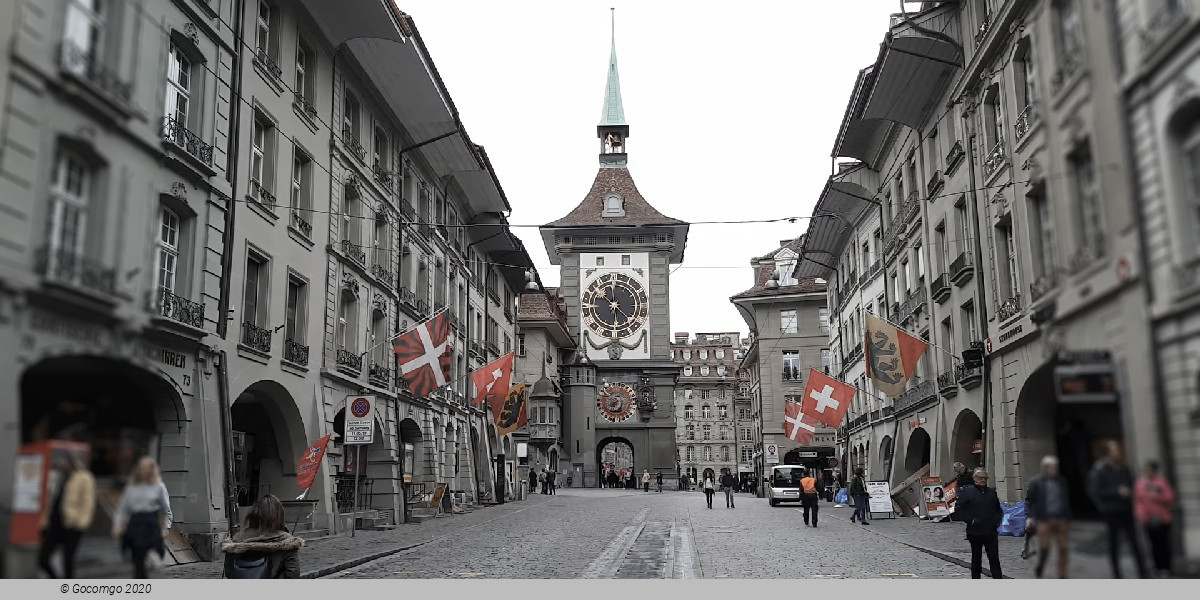Bern

Bern is the de facto capital of Switzerland, referred to by the Swiss as their "federal city", in German: Bundesstadt, French: ville fédérale, and Italian: città federale. Bern is also the capital of the canton of Bern, the second-most populous of Switzerland's cantons. The official language in Bern is the Swiss variety of Standard German, but the most-spoken language is an Alemannic Swiss German dialect, Bernese German. In 1983, the historic old town in the centre of Bern became a UNESCO World Heritage Site.
No archaeological evidence that indicates a settlement on the site of today's city centre prior to the 12th century has been found so far. In antiquity, a Celtic oppidum stood on the Engehalbinsel (peninsula) north of Bern, fortified since the second century BC (late La Tène period), thought to be one of the 12 oppida of the Helvetii mentioned by Caesar. During the Roman era, a Gallo-Roman vicus was on the same site. The Bern zinc tablet has the name Brenodor ("dwelling of Breno"). In the Early Middle Ages, a settlement in Bümpliz, now a city district of Bern, was some 4 km (2 mi) from the medieval city.
The medieval city is a foundation of the Zähringer ruling family, which rose to power in Upper Burgundy in the 12th century. According to 14th-century historiography (Cronica de Berno, 1309), Bern was founded in 1191 by Berthold V, Duke of Zähringen.
In 1218, after Berthold died without an heir, Bern was made a free imperial city by the Goldene Handfeste of Holy Roman Emperor Frederick II.
In 1353, Bern joined the Swiss Confederacy, becoming one of the eight cantons of the formative period of 1353 to 1481.
Bern invaded and conquered Aargau in 1415 and Vaud in 1536, as well as other smaller territories, thereby becoming the largest city-state north of the Alps; by the 18th century, it comprised most of what is today the canton of Bern and the canton of Vaud.
The city grew out towards the west of the boundaries of the peninsula formed by the river Aare. The Zytglogge tower marked the western boundary of the city from 1191 until 1256, when the Käfigturm took over this role until 1345. It was, in turn, succeeded by the Christoffelturm (formerly located close to the site of the modern-day railway station) until 1622. During the time of the Thirty Years' War, two new fortifications – the so-called big and small Schanze (entrenchment) – were built to protect the whole area of the peninsula.
After a major blaze in 1405, the city's original wooden buildings were gradually replaced by half-timbered houses and subsequently the sandstone buildings which came to be characteristic for the Old Town. Despite the waves of pestilence that hit Europe in the 14th century, the city continued to grow, mainly due to immigration from the surrounding countryside.
Bern was occupied by French troops in 1798 during the French Revolutionary Wars, when it was stripped of parts of its territories. It regained control of the Bernese Oberland in 1802, and following the Congress of Vienna of 1814, it newly acquired the Bernese Jura. At this time, it once again became the largest canton of the Confederacy as it stood during the Restoration and until the secession of the canton of Jura in 1979. Bern was made the Federal City (seat of the Federal Assembly) within the new Swiss federal state in 1848.
A number of congresses of the socialist First and Second Internationals were held in Bern, particularly during World War I when Switzerland was neutral; see Bern International.
The city's population rose from about 5,000 in the 15th century to about 12,000 by 1800 and to above 60,000 by 1900, passing the 100,000 mark during the 1920s. Population peaked during the 1960s at 165,000 and has since decreased slightly, to below 130,000 by 2000. As of September 2017, the resident population stood at 142,349, of which 100,000 were Swiss citizens and 42,349 (31%) resident foreigners. A further estimated 350,000 people live in the immediate urban agglomeration.

